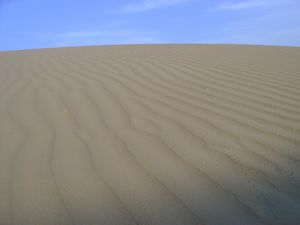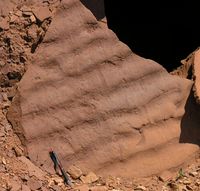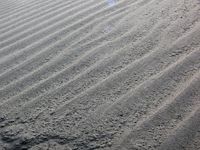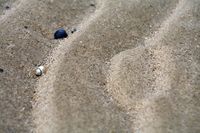علامات النيم

علامات النيم إنگليزية: Ripple marks وهي عبارة عن تموجات صغيرة على سطح الطبقة العلوية للأرض وتنشأ بفعل الرياح أو التيارات الشاطئية أو الأمواج. ويلاحظ أن تموجات الرياح والتيارات البحرية تتشابه في عدم تماثل شكلها على سطح الرمال. ويمكن من خلال اتجاه ميل هذه العلامات تحديد اتجاه الريح أو التيارات البحرية التي شكلتها. أما علامات النيم الناتجة من فعل الأمواج فغالبا ما تكون متماثلة الشكل وتتميز بقممها الحادة التي تبين أعلى الطبقة وقيعانها المنحنية أو المقوسة.
تعريف التموج عبر الصفيحة والتموجات غير المتماثلة

| مستقيم |
Straight ripples generate cross-laminae that all dip in the same direction, and lay in the same plane. These forms of ripples are constructed by unidirectional flow of the current. |
|---|---|
| موجي |
Sinuous ripples generate cross-laminae that are curvy. They show a pattern of curving up and down as shown in picture. Sinuous ripples produce trough cross lamination. All laminae formed under this type of ripple dip at an angle to the flow as well as downstream. These are also formed by unidirectional flow of current. |
| متسلسل |
Catenary ripples generate cross-laminae that are curvy but have a unidirectional swoop. They show a pattern similar to what a repeated "W" would look like. Like the sinuous ripples, this form of ripple is created by unidirectional flow with the dip at an angle to the flow as well as downstream. |
| Linguoid / Lunate |
Linguoid ripples have lee slope surfaces that are curved generating a laminae similar to caternary and sinuous ripples. Linguoid ripples generate an angle to the flow as well as downstream. Linguoid ripples have a random shape rather than a "W" shape, as described in the catenary description. Lunate ripples, meaning crescent shaped ripples, are exactly like linguoid ripples except that the stoss sides are curved rather than the lee slope. All other features are the same. |
| المقاس | الوصف |
|---|---|
| صغيرة جداً | Very small cross-lamination means that the ripple height is roughly one centimeter. It is lenticular, wavy and flaser lamination. |
| سغيرة | Small cross-bedding are ripples set at a height less than ten centimeters, while the thickness is only a few milimeters. Some ripples that may fit this category are wind ripples, wave ripples, and current ripples. |
| Medium | Medium cross-lamination are ripples with a height greater than ten centimeters, and less than one meter in thickness. Some ripples that may fit this category would be current-formed sandwaves, and storm-generated hummocky cross stratification. |
| Large | Large cross-bedding are ripples with a height greater than one meter, and a thickness equivalent to one meter or greater. Some ripples that may fit this category would be high energy river-bed bars, sand waves, epsilon cross-bedding and Gilbert-type cross-bedding. |
الموجة التي شكلت علامات النيم
Ripple marks formed by aeolian processes
تعاريف
انظر أيضا
المصادر
| Ripple marks
]].- Easterbrook, Don J. Surface processes and landforms. Upper Saddle River, N.J: Prentice Hall, 1999. Print. ISBN 0-13-860958-6 pp. 479-480.
- Greeley, Ronald, and James D. Iversen. Wind as a Geological Process On Earth, Mars, Venus and Titan (Cambridge Planetary Science Old). New York: Cambridge UP, 1987. ISBN 0-521-35962-7 pp. 153-154
- Monroe, James S., and Reed Wicander. The Changing Earth: Exploring Geology and Evolution, 2nd ed. Belmont: West Publishing Company, 1997. ISBN 0-314-09577-2 pp. 114-15, 352.
وصلات خارجية
- Ripple Marks and Uniformitarianism
- Unidirectional flow: Sand ripples and grain distribution 2D model
- Unidirectional flow: Sand ripples and topography 2D model
- Waves: Sand ripples and grain distribution 2D model
- Waves: Sand ripples and topography 2D model
| هذا article متعلقة بعلم الصخور هو بذرة. بإمكانك مساعدة المعرفة بأن تنمـِّـيـه. |







